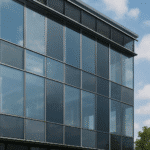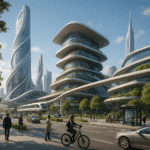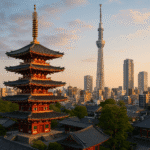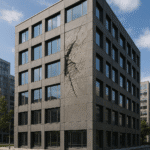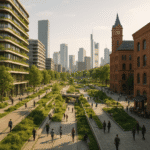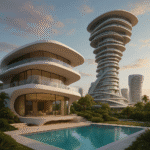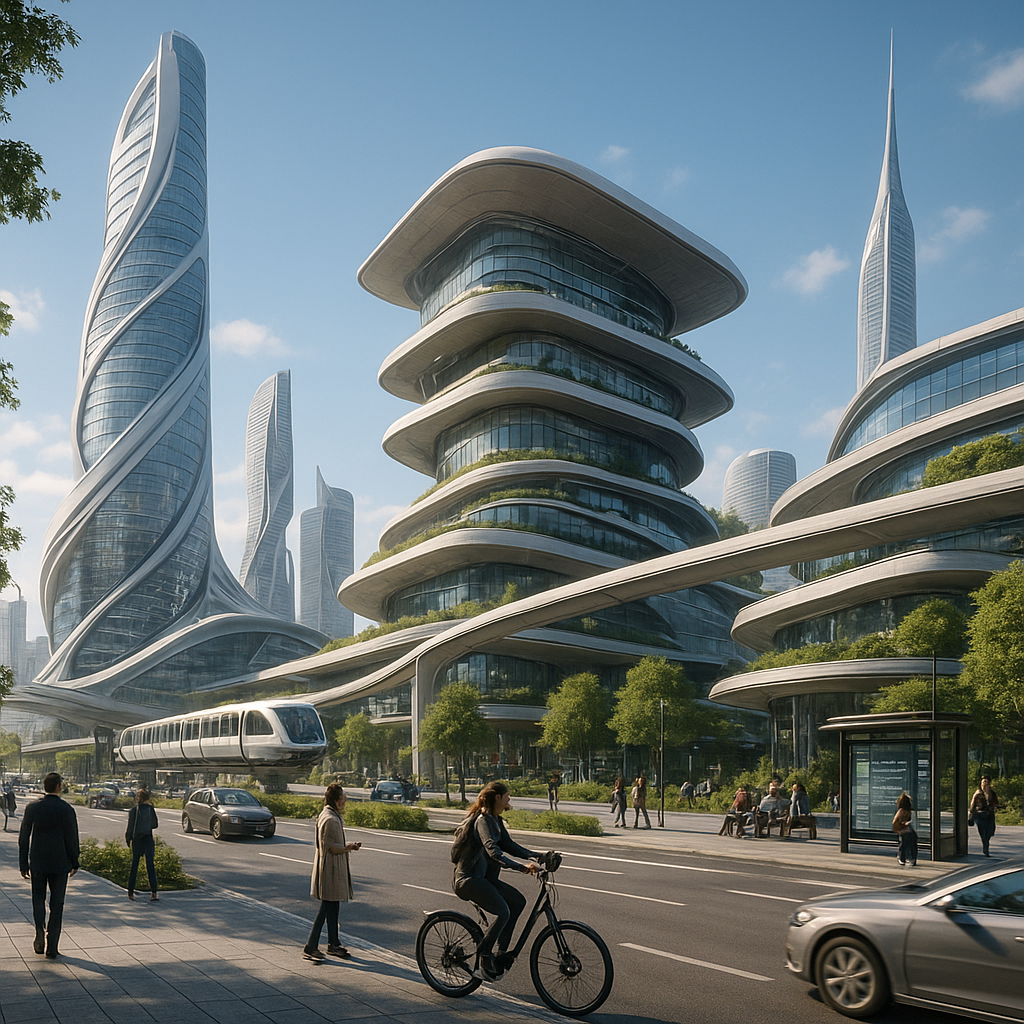As we stand on the brink of a new era in design and construction, the top 10 architectural projects that will define the next decade are already beginning to take shape. These groundbreaking endeavors promise to revolutionize the way we think about urban spaces, sustainability, and the integration of technology into our built environment. From towering skyscrapers to sprawling eco-cities, these projects are not just feats of engineering but also bold statements about the future of human habitation.
1. The Vertical City: A New Paradigm in Urban Living
The concept of the vertical city is rapidly gaining traction as urban populations continue to swell. These towering structures are designed to be self-sufficient ecosystems, incorporating residential, commercial, and recreational spaces within a single, vertically integrated environment. The idea is to minimize the urban footprint while maximizing the use of available space.
One of the most ambitious projects in this category is the Sky City in Changsha, China. Planned to reach a height of 838 meters, this megastructure aims to house over 30,000 people and include schools, hospitals, offices, and even vertical farms. The design emphasizes sustainability, with energy-efficient systems and green spaces integrated throughout the building.
Another notable project is the Bosco Verticale in Milan, Italy. This pair of residential towers is covered in over 20,000 trees and plants, creating a vertical forest that improves air quality and provides a habitat for urban wildlife. The Bosco Verticale has set a new standard for biophilic design, demonstrating how architecture can harmonize with nature.
2. Floating Cities: Adapting to Rising Sea Levels
As climate change continues to raise sea levels, architects are exploring innovative solutions to keep coastal cities afloat. Floating cities are emerging as a viable option, offering resilient and adaptable living spaces that can withstand the challenges of a changing climate.
One of the most talked-about projects in this realm is Oceanix City, a collaboration between the United Nations and the architectural firm BIG. Designed to accommodate up to 10,000 residents, Oceanix City consists of interconnected floating platforms that can be expanded or reconfigured as needed. The city is designed to be self-sustaining, with renewable energy sources, closed-loop water systems, and urban agriculture.
In the Netherlands, the Floating Pavilion in Rotterdam serves as a prototype for future floating developments. This innovative structure is not only a venue for events and exhibitions but also a testbed for sustainable technologies. The pavilion’s design incorporates solar panels, rainwater harvesting, and a lightweight, buoyant construction that adapts to changing water levels.
3. Smart Cities: Integrating Technology and Urban Design
The rise of smart cities represents a significant shift in how we design and manage urban environments. By leveraging advanced technologies such as the Internet of Things (IoT), artificial intelligence, and big data, smart cities aim to enhance the quality of life for their residents while optimizing resource use and reducing environmental impact.
Songdo International Business District in South Korea is often cited as a leading example of a smart city. Built from scratch on reclaimed land, Songdo integrates cutting-edge technology into every aspect of urban life. From smart traffic management systems to energy-efficient buildings, the city is designed to be a model of sustainability and connectivity.
In Toronto, the Sidewalk Labs project, a subsidiary of Alphabet Inc., is reimagining urban living with a focus on technology and innovation. The project aims to create a neighborhood that prioritizes sustainability, affordability, and inclusivity, using data-driven solutions to address urban challenges.
4. Eco-Cities: Pioneering Sustainable Urban Development
Eco-cities are at the forefront of sustainable urban development, designed to minimize environmental impact while promoting a high quality of life. These cities prioritize green spaces, renewable energy, and efficient resource management, setting a new standard for urban planning.
Masdar City in the United Arab Emirates is a pioneering example of an eco-city. Designed to be carbon-neutral and zero-waste, Masdar City incorporates a range of sustainable technologies, including solar power, wind energy, and water recycling. The city’s layout encourages walking and cycling, reducing reliance on cars and promoting a healthier lifestyle.
Tianjin Eco-City in China is another ambitious project that aims to create a sustainable urban environment. Developed in partnership with Singapore, the city features green buildings, extensive public transportation, and a focus on renewable energy. Tianjin Eco-City serves as a model for future developments in China and beyond.
5. Adaptive Reuse: Transforming the Past for the Future
Adaptive reuse is gaining popularity as a sustainable approach to urban development. By repurposing existing structures, architects can preserve cultural heritage while meeting modern needs. This approach reduces the environmental impact of new construction and breathes new life into historic buildings.
The High Line in New York City is a prime example of adaptive reuse. Once an elevated railway, the High Line has been transformed into a linear park that attracts millions of visitors each year. The project has revitalized the surrounding neighborhood, spurring economic development and creating a vibrant public space.
In London, the Battersea Power Station redevelopment is another notable adaptive reuse project. This iconic industrial building is being transformed into a mixed-use development, featuring residential, commercial, and cultural spaces. The project preserves the historic character of the power station while introducing modern amenities and sustainable design elements.
6. Parametric Design: Pushing the Boundaries of Form and Function
Parametric design is revolutionizing the field of architecture, allowing designers to create complex, organic forms that were previously unimaginable. By using algorithms and computational tools, architects can explore new possibilities in form and function, resulting in innovative and efficient designs.
The Heydar Aliyev Center in Baku, Azerbaijan, designed by Zaha Hadid Architects, is a stunning example of parametric design. The building’s fluid, curvilinear form challenges traditional notions of architecture, creating a dynamic and visually striking structure. The design is not only aesthetically pleasing but also highly functional, with flexible interior spaces that can accommodate a variety of uses.
Another remarkable project is the Morpheus Hotel in Macau, China. Designed by Zaha Hadid Architects, the hotel features a unique exoskeleton structure that allows for large, open spaces without the need for internal columns. The design is both visually captivating and structurally efficient, showcasing the potential of parametric design in modern architecture.
7. Modular Construction: Building the Future, One Module at a Time
Modular construction is gaining popularity as a cost-effective and efficient method of building. By prefabricating modules off-site and assembling them on-site, architects can reduce construction time, minimize waste, and improve quality control. This approach is particularly well-suited to large-scale projects and urban environments.
The B2 Tower in Brooklyn, New York, is a pioneering example of modular construction. As the tallest modular building in the world, the B2 Tower demonstrates the potential of this construction method for high-rise developments. The building’s modules were manufactured off-site and assembled on-site, significantly reducing construction time and costs.
In the UK, the Y:Cube project by the YMCA is another innovative use of modular construction. Designed to provide affordable housing, the Y:Cube units are prefabricated and can be quickly assembled on-site. The project addresses the pressing need for affordable housing while showcasing the versatility and efficiency of modular construction.
8. Biophilic Design: Bringing Nature into the Built Environment
Biophilic design is an emerging trend that seeks to reconnect people with nature through architecture. By incorporating natural elements and patterns into the built environment, biophilic design aims to enhance well-being, reduce stress, and improve productivity.
The Amazon Spheres in Seattle, Washington, are a striking example of biophilic design. These glass domes house a lush indoor rainforest, providing a unique workspace for Amazon employees. The design emphasizes the importance of nature in the workplace, creating a calming and inspiring environment.
In Singapore, the Jewel Changi Airport is another remarkable example of biophilic design. The airport features a stunning indoor waterfall and a vast indoor garden, creating a serene and immersive experience for travelers. The design highlights the potential of biophilic design to transform public spaces and enhance the travel experience.
9. 3D Printing: Revolutionizing Construction Techniques
3D printing is poised to revolutionize the construction industry, offering new possibilities for design and fabrication. By using additive manufacturing techniques, architects can create complex structures with unprecedented precision and efficiency.
The 3D-printed office building in Dubai is a groundbreaking example of this technology in action. As the world’s first fully functional 3D-printed building, it demonstrates the potential of 3D printing for large-scale construction. The building was printed in layers using a special concrete mixture, significantly reducing construction time and costs.
In the Netherlands, the 3D-printed bridge in Amsterdam is another innovative use of this technology. The bridge was printed using a robotic arm and a steel wire, creating a strong and durable structure. The project showcases the potential of 3D printing for infrastructure development and highlights the versatility of this technology.
10. Zero-Energy Buildings: Leading the Way in Sustainable Design
Zero-energy buildings are at the forefront of sustainable design, aiming to produce as much energy as they consume. By incorporating renewable energy sources and energy-efficient technologies, these buildings minimize their environmental impact and reduce operating costs.
The Edge in Amsterdam is a leading example of a zero-energy building. This innovative office building is powered by solar panels and features a range of energy-efficient systems, including smart lighting and climate control. The design emphasizes sustainability and connectivity, creating a cutting-edge workspace for its occupants.
In the United States, the Bullitt Center in Seattle is another notable zero-energy building. Designed to be the greenest commercial building in the world, the Bullitt Center incorporates a range of sustainable features, including rainwater harvesting, composting toilets, and a rooftop solar array. The building serves as a model for future developments and demonstrates the potential of zero-energy design.
As we look to the future, these top 10 architectural projects offer a glimpse into the possibilities of the next decade. By embracing innovation, sustainability, and technology, these projects are not only redefining the built environment but also shaping the way we live, work, and interact with the world around us.
